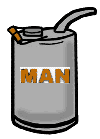|
Past Preventive Maintenance columns: Zero
Points on Machining Centers—Machining Centers vs.
Lathes Completing
Lathe Maintenance—Tailstock, Sub-Spindle, and
Zero-Point Alignment A
Closer Look at Spindles and Turrets The
Next Level: Accuracy—Checking Backlash on Lathes
Inspecting
the Electrical Cabinet Everyone's
Favorite Task—Cleaning Coolant—The
Most Ignored Fluid in your Machines It's
Summertime—Is your Chiller Working? The
Other Oils—Inspecting the Main Hydraulic Systems
|
MIKE BREEN ON PREVENTIVE MAINTENANCE |
|
Examining Accuracies by Michael W. Breen |
|
|
This is what doing PMs is all about. Now, on to this month’s topic: machining center accuracies. What Is Backlash? Backlash is the mechanical loss of motion that can result from a mechanical or electrical problem. We addressed the issue of backlash on lathes a couple of months ago. Machining centers, for the most part, have the same type of feed systems as lathes and are checked the same way. In case you missed that article, we will briefly explain the feed system and how it works. The Feed System A feed system or axis consists of a servo-driven motor, one or more feedback devices (used for motor rpm and positioning), a ball screw or some actuated feed device, bearings, gear belts, gears, coupling devices, and key stock. Depending on your machine type, you could have all of these devices in your system or just two or three. (Refer to your machine’s parts drawings.) Any of these components could be the demon that causes backlash. How Does it Work? The control sends a command to the axis drive telling it to move. The command specifies how far to travel, in which direction, and how fast it should get there. Here is where the feedback devices come into play. The motor starts to rotate, and the feedback device coupled to the motor starts to send the control signals of speed and positioning. (You also may have scales and/or other positioning devices coupled to the ball screw doing the same thing.) The control wants to see a match and will constantly monitor the movement and update the command so that the feedback and command will match. When they do not match and the axis is unable to keep up with the control or is running away, a following error results. A following error is the gap between where the control thinks the axis should be versus where the axis actually is (or where the feedback devices is telling the control where it is). If the following error becomes too large, the control will fault out. Backlash, unless extreme, will not cause following errors. What it will cause is inaccurate movement of the axis and finish problems because the control will think it is in the proper position due to the feedback telling it that it is. Scales If you have scales mounted to the axis, mispositioning will be rare even though backlash still exists. Scales are mounted along the length of the axis with a sensor mounted to the moving part of the slide. Positioning then relies on the position of the sensor to the scale, not the positioning sent from the feedback device mounted to the motor. If the gap is too great between the two, a following error fault could result. With scales, the finish of the cut is a good indicator if something is loosening up. Checking for Backlash Use the same procedure we did on the lathes to check for backlash, and remember the rules. Do not use a pulse handle; either use MDI commands or write a small program. Remove any backlash compensation from the control parameters. Compensations can remove backlash electronically to a point. Go into the indicator in opposite directions. The indicator should return to the original position. If you make a change in the parameters, always take notes on everything you do from the original amount to the final input. Now, go out there and tighten up that axis. Next time we will discuss particular axes, explain the NC (numerical control) table, and examine the B-axis index table. We will also get much deeper into the mechanical repair and the effects of making changes. Talk to you next month. Mike Breen’s career of more than 14 years in machine tool repair includes his experience as an aircraft electrician in the U.S. Army’s 101st Airborne. As a Certified Electronic Engineer, he presently is working as a Field Service Engineer with Ellison Machinery Company of Wisconsin. Mike has held this position for more than six years, during which he has designed and implemented complete preventive maintenance programs for many successful companies. He invites you to share your own machine repair and maintenance experiences with him. For comments and inquiries about these articles, his e-mail address is mbreen@ellisonwi.com. - March 2001 |

 All the seemingly “little” things we have done to your machines over the past year should now really be making a difference in machine downtime and accuracy.
All the seemingly “little” things we have done to your machines over the past year should now really be making a difference in machine downtime and accuracy.